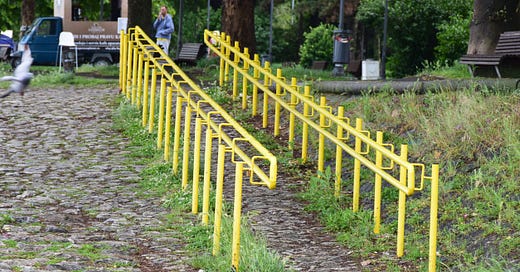You can listen to the main article in this newsletter here:
Accessibility initiatives that are not genuine may do more harm than good. While the annual report showcases purple-lit stations and heartwarming awareness events, disabled customers might still struggle daily with unusable services. In the transport sector, where accessibility challenges are complex and visible, leaders often fall into the trap of performative action – initiatives that create the appearance of progress while changing nothing fundamental about service delivery.
This can create an illusion of accessibility that is ineffective in reality – it's actively harmful, creating organisational shortcomings, wasting resources, and silencing the very voices by claiming to amplify them. When an organisation celebrates tokenistic achievements while disabled passengers continue to face the same barriers, it’s not just failing at inclusion – it’s making meaningful change even harder to achieve.
The Cost of Performative Accessibility
It's worse to pretend to care about accessibility than to do nothing at all. This fake effort is harmful because it makes organisations and their stakeholders believe the organisation is making a difference when they aren't. It also silences disabled people who want to participate in society, use services and live an equal life. When they raise concerns, they are often told that something has already been done - the performative action - even if there wasn't any real change.
Some examples of fake accessibility efforts? Inviting disabled people, asking for their demands and needs and then doing nothing except using this engagement to tell the world there was engagement with disabled people. That can create a really bad culture for stakeholder engagement in the long term because people will be less and less willing to give input if they feel it’s not appreciated and in fact, abused.
Other examples are symbolic events like "singing and clapping" events, as I call them, to “raise awareness" without making any difference for the community affected by the topic at all when they need action, not just awareness.
These fake initiatives seem designed to calm people down and silence them rather than improve the reality for disabled people. This often happens in organisations that resist change and struggle with innovation and openness. They don't want to improve things; they want to appear like they care when they don’t or are so change-averse that this seems to be the better option.
There's also a political angle to this issue. I studied Political Science, and one of the things I learnt that stuck with me was that when politics only partially meets the demands of a social movement, it can weaken the movement massively. Pretending to do something or meeting a few demands can stop the movement in its tracks without fully achieving its goals.
So, how do you spot these initiatives that are, in fact, window dressing? Ask yourself if the initiatives, projects and PR measures really improve the lives of disabled people or if it is just a performative or political move to weaken the voice of disabled people and make complaints more difficult. Talk to disabled people about what they think about the initiative in a most neutral way. "Don't you think that's an amazing initiative?" isn't neutral, by the way. Ask yourself if the initiative really aims to change people’s behaviour or organisational processes to become more inclusive.
Innovation and Accessibility
Last but not least, we have innovation and accessibility initiatives. Many moons ago, I stumbled upon a YouTube video that I presumed wasn’t intended for the public. Someone must have tampered with the settings, or perhaps even worse, if the people in this video genuinely believed it was acceptable to discuss accessibility in such a casual manner in a professional setting. In this video, one person mentioned that the product they were considering purchasing had the advantage that the company didn’t have to make any significant efforts. While they weren’t entirely certain if this truly benefited disabled people, they did agree that it would improve the organisation’s reputation.
As budgets are not unlimited, this was a publicly announced waste of money for the benefit of reputation but not accessibility. Public money, in this case, by the way.
Disability and accessibility can drive innovation, and they certainly do. That should be supported. However, I genuinely wish people would ask themselves more often, “Is this truly useful?” And the government should ask itself more often, “Do we genuinely need to fund another innovation project and pretend that nothing already exists? Or do we have to mandate something that has already solved this issue, as we have done in numerous aspects of life?”. I’m thinking of level boarding.
To create meaningful accessibility improvements, transport providers and the government must move beyond performative gestures and implement substantive changes that actually improve the passenger experience for disabled customers. This requires genuine commitment, adequate resources, and ongoing consultation with disabled users as equal partners in the development process.
Some interesting links
The web accessibility agency TetraLogical published a good overview of what the new European Accessibility Act (EAA) means for businesses and consumers, e.g., in transport, the accessibility of self-service terminals will become mandatory. This might also impact the UK because many products and software are getting developed for both markets, the EU and the UK. Being optimistic, the UK might indirectly benefit from this law, too. And everyone who sells products to the EU should know the new regulations.
One step is maybe the barrier I experience most often, especially with smaller shops. So good so to see that Iceland built 1,756 wheelchair ramps in the past 4 years.
The Presidency of the EU invited the Vice-President of the European Disability Forum to give a speech on the use of EU funds for disabled people. An airline prevented her from arriving because she is a powerchair user.
Something to read
In 2023, London TravelWatch released a report entitled Left out Londoners, which looked at the issues faced by digitally excluded or disadvantaged passengers who might not have access to digital technologies before and during their journey.
Two years later, they wanted to see what progress – if any – had been made and carried out a mystery shopping exercise across London’s public transport network. One of their (unsurprising) findings: Staff can be vital to help people on their journey, providing support, help and information. You can find the new report here, which has an easy read and plain text version, too.
Something to watch
Transport for London has taken an agency out of its tender process after the agency scrapped its diversity, equity, and inclusion goals. That’s how good procurement works. Action, not just words.
Some final words
The Accessible Link is a reader-supported publication. So, if you like what you’re reading, consider to
As a paid subscriber you will receive an additional edition every two weeks with best-practice tips on improving accessibility in your organisation.
Who is writing this newsletter?
I’m Christiane Link, and I improve the customer experience in aviation, transport, and travel. I worked as a journalist for over two decades and travelled extensively for business and leisure. I’m a wheelchair user.
Work with me
Whether you're a Customer service director, a Head of Customer Experience, a corporate Accessibility manager, a DEI leader, a transport planner, or a disabled employee resource group member, I can help you to make your organisation more inclusive. You can book me for speaking engagements or hire me as a consultant for your accessibility or DEI strategy, communications advice and other related matters. I have worked for airlines, airports, train operators, public transport providers, and companies in other sectors.
If you want to read more from me, follow me on LinkedIn, Twitter, Bluesky or Mastodon. You can also reply to this email if you want to contact me.
.







